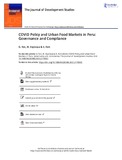COVID Policy and Urban Food Markets in Peru: Governance and Compliance
| dc.contributor.author | Ton, Giel | |
| dc.contributor.author | Espinoza, Mauricio | |
| dc.contributor.author | Fort, Ricardo Adolfo | |
| dc.coverage.spatial | Peru | en |
| dc.date.accessioned | 2023-02-27T10:00:14Z | |
| dc.date.available | 2023-02-27T10:00:14Z | |
| dc.date.issued | 2023-02-19 | |
| dc.identifier.citation | Ton, G.; Espinoza, M. and Fort, R. (2023) COVID Policy and Urban Food Markets in Peru: Governance and Compliance, The Journal of Development Studies, DOI: 10.1080/00220388.2023.2178303 | en |
| dc.identifier.uri | https://opendocs.ids.ac.uk/opendocs/handle/20.500.12413/17893 | |
| dc.description.abstract | Urban food markets are essential channels of food distribution and spaces of social interaction where COVID-19 could be easily transmitted. The Peruvian government used budget incentives to motivate local governments to implement social distancing and food safety measures in these markets. Two surveys, in May and November 2020, show that municipality-owned markets had better compliance than privately or vendor-owned markets, especially with vendor protection measures and common space adaptations. Qualitative interviews helped to identify plausible causal mechanisms that explain this finding. Local governments perceived legal restrictions to investing public funds in privately owned markets, while vendor-owned markets faced agency dilemmas and opportunistic behaviour in decision-making about the required collective investments. We argue that a small-grants or loan facility specifically targeted at vendor-owned markets could have reduced these governance challenges and improved compliance. Peru’s budget incentive policy to support food market governance could inspire other countries to design appropriate policy instruments for food safety and public health. | en |
| dc.language.iso | en | en |
| dc.publisher | Routledge, Taylor & Francis Group | en |
| dc.rights | This is an Open Access article distributed under the terms of the Creative Commons Attribution-NonCommercial-NoDerivatives License (http://creativecommons.org/licenses/by-nc-nd/4.0/), which permits non-commercial re-use, distribution, and reproduction in any medium, provided the original work is properly cited, and is not altered, transformed, or built upon in any way. | en |
| dc.rights.uri | http://creativecommons.org/licenses/by-nc-nd/4.0/ | en |
| dc.subject | Governance | en |
| dc.subject | Rural Development | en |
| dc.title | COVID Policy and Urban Food Markets in Peru: Governance and Compliance | en |
| dc.type | Article | en |
| dc.rights.holder | © 2023 The Author(s). | en |
| dc.identifier.externaluri | https://doi.org/10.1080/00220388.2023.2178303 | |
| dc.identifier.team | Rural Futures | en |
| dc.identifier.doi | 10.1080/00220388.2023.2178303 | |
| dcterms.dateAccepted | 2023-01-21 | |
| rioxxterms.funder | Default funder | en |
| rioxxterms.version | VoR | en |
| rioxxterms.versionofrecord | 10.1080/00220388.2023.2178303 | en |
Files in this item
This item appears in the following Collection(s)
Except where otherwise noted, this item's license is described as This is an Open Access article distributed under the terms of the Creative Commons Attribution-NonCommercial-NoDerivatives License (http://creativecommons.org/licenses/by-nc-nd/4.0/), which permits non-commercial re-use, distribution, and reproduction in any medium, provided the original work is properly cited, and is not altered, transformed, or built upon in any way.


